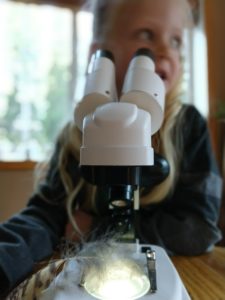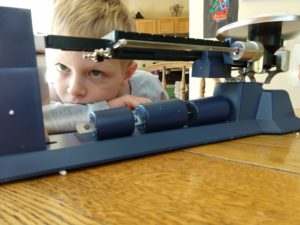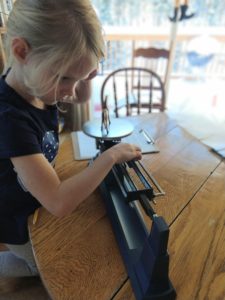Find out how you can transform any space in your home into a educational math and science learning lab.
Kids are curious and want to learn.
By nature, kids are curious and want to explore. Providing lots of opportunities for kids to explore the world around them grows their passion for learning. With the right tools, parents and teachers can elevate child-driven explorations from tinkering to valuable lessons. These self-initiated lessons can be some of the most meaningful, memorable lessons for children because they get to be their own expert and find their own path at their own pace.
How can we up the ante so that children learn instead of just playing?
Educators like to use the word ‘rigor’ to describe tasks that contain appropriately challenging work. To understand what rigor is, we could use leaves as an example.
In a task without rigor, students might collect different leaves and make a collage with them. By comparison, students working through a rigorous task would collect leaves and count the number of lobes the leaves have, then compile the class’s data and graph the results. They could still create a collage if time allowed, but the emphasis of the lesson would be on helping children utilize their math skills. Depending on each child’s mathematical readiness, students would practice anything from basic counting and pattern recognition to creating a data table and graphing. Regardless of ability, the whole class would ultimately participate in a discussion to elicit the interesting fact that the number of lobes in a leaf is almost always odd.
Rigor is one important aspect of providing children with high-quality learning tasks. Another equally essential element is that the tasks are open-ended.
Open-ended means that there is freedom to explore as much as the child wants to. While it is important to set minimal goals and expectations, the final learning outcomes should be left up to the individual child as often as possible. Children set free on open-ended tasks will often exceed the boundaries of the task because they are so engaged. This gets students away from becoming dependent on knowing whether solutions are right or wrong and teaches valuable critical thinking and problem-solving skills. Open-ended tasks also help students’ self-confidence grow, which is especially crucial for success in math.
Now obviously, putting an open-ended task in front of a child and having high expectations isn’t enough to set them free down the path of engaged, meaningful learning.
For engaged, authentic learning to take place, tasks need to be interesting.
There are two incredible instruments available from Amazon for under $100 that we are head over heels about in The Biggest Classroom!
Both will transform any home or classroom into a math and science learning lab, almost all by themselves! What makes these such great tools for kids’ learning is that they:
- are inherently fascinating to use
- provide insane amounts of rigor
- have unlimited possibilities with no end in sight!
The Biggest Classroom Favorite Instrument #1:
SOLOMARK Portable Stereo Microscope-20X-40X Lab LED Binocular Microscope with a Microscope Smartphone Adapter

Expand the world and invite your child to open the door to the microscopic world! This microscope is the perfect way for children to start learning how to correctly use a microscope. Designed for viewing solid objects that are bulky, the stereo microscope works perfectly with just about anything your child can think to look at up close.
One thing I especially love is being able to take pictures of what children see with the ease of a smartphone. This has led to some truly awesome discussions in The Biggest Classroom, and adds validation to students’ inquiries that might otherwise be forgotten. Any time kids are talking about what they’re experiencing, they are learning.
Look at these incredible images from our Microscope Intro lesson in The Biggest Classroom:


With pictures of cool stuff made this easy, students can make their own digital books about what they see, write reports that are illustrated with their own images, and share their findings with their family, their teachers and the whole world if they want to! Talk about empowering children to become their own experts!
The Biggest Classroom Favorite Instrument #2:
Walter Products B-300-W-O Economy Triple Beam Balance with Tare and Weight Set, 2610 g Capacity
With a hundreds, tens, and units weight, this instrument is the perfect complement to learning place value! Through their own exploration with a triple beam balance, most children will easily notice that when the small weight reaches 10, they need to exchange it for the next bigger weight– the tens weight. When the tens weight gets to 100 and the balance is still pointing at the sky, kids again rapidly figure out that they must exchange for the hundreds weight.
Children have a blast selecting their own objects to measure, and increase their mathematical fluency as they add up the three weights to find the total mass of each object.
With some scaffolding, the triple beam balance even makes a fabulous entry point into decimals, since the smallest tick marks on the units beam are tenths.
Any time math concepts can be seen, put into action and made into a cause and effect type of experiment, it’s a win! Too often, these elements are removed from the mathematics classroom because there just isn’t time for it. The unfortunate part is that experimenting and puzzling is the fun of real mathematics. It’s where right and wrong don’t matter nearly as much as critical thinking skills and self-confidence. How cool that a useful, tool like this has the power to help!
The right opportunities at the right times.
By transforming a home or classroom into a place of math and science exploration, we can help children understand and enjoy learning. We can help them learn for life, not just for the moment, and they can do it at their own pace.
The Biggest Classroom strives to weave challenging content into lessons about highly engaging topics to help make learning fun, even when it involves challenging mathematics. We often incorporate real instruments like these because children are far more likely to want to participate when tasks create a legitimate reason to find out the answer– a need to know. Not surprisingly, children’s understanding and retention of concepts is much higher with these types of authentic learning learning tasks.
Please keep in mind that because these are actual instruments, you may need to help your child use the recommended equipment safely. Please be sure to follow all manufacturer’s guidelines and help your child as needed to keep him/ her safe.


